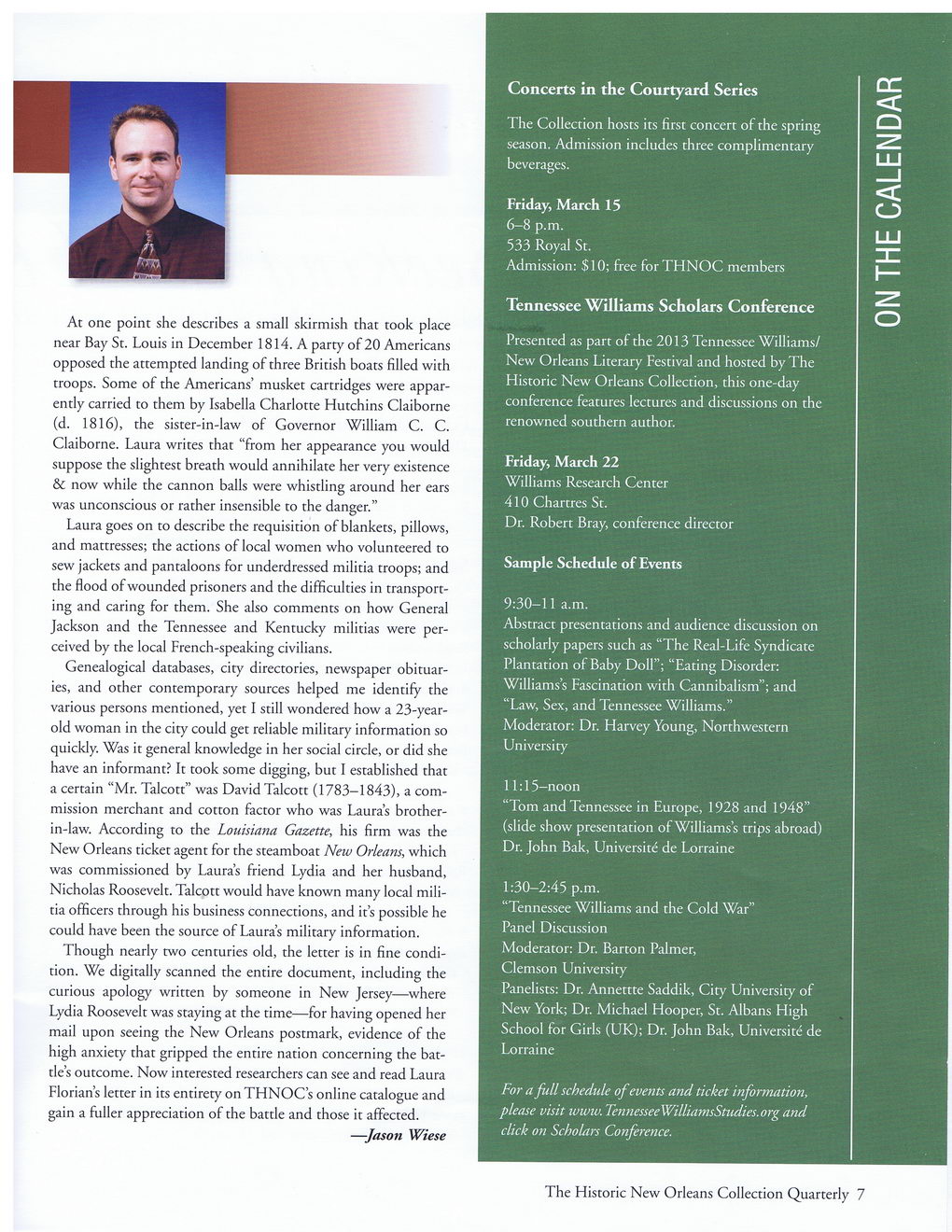This text was obtained via automated optical character recognition.
It has not been edited and may therefore contain several errors.
Concerts in the Courtyard Series The Collection hosts its first concert of the spring season. Admission includes three complimentary beverages. Friday, March 15 6-8 p.m. 533 Royal St. Admission: $10; free for THNOC members Tennessee Williams Scholars Conference Presented as part of the 2013 Tennessee Williams/ New Orleans Literary Festival and hosted by The Historic New Orleans Collection, this one-day conference features lectures and discussions on the renowned southern author. Friday, March 22 Williams Research Center 410 Chartres St. Dr. Robert Bray, conference director Sample Schedule of Events 9:30-11 a.m. Abstract presentations and audience discussion on scholarly papers such as “The Real-Life Syndicate Plantation of Baby Doll”; “Eating Disorder: Williams’s Fascination with Cannibalism”; and “Law, Sex, and Tennessee Williams.” Moderator: Dr. Harvey Young, Northwestern University 11:15-noon “Tom and Tennessee in Europe, 1928 and 1948” (slide show presentation of Williams’s trips abroad) Dr. John Bak, Universite de Lorraine 1:30—2:45 p.m. “Tennessee Williams and the Cold War” Panel Discussion Moderator: Dr. Barton Palmer, Clemson University Panelists: Dr. Annettte Saddik, City University of New York; Dr. Michael Hooper, St. Albans High School for Girls (UK); Dr. John Bak, Universite de Lorraine For a full schedule of events and ticket information, please visit wwiv. TennesseeWilliamsStudies.org and click on Scholars Conference. At one point she describes a small skirmish that took place near Bay St. Louis in December 1814. A party of 20 Americans opposed the attempted landing of three British boats filled with troops. Some of the Americans’ musket cartridges were apparently carried to them by Isabella Charlotte Hutchins Claiborne (d. 1816), the sister-in-law of Governor William C. C. Claiborne. Laura writes that “from her appearance you would suppose the slightest breath would annihilate her very existence & now while the cannon balls were whistling around her ears was unconscious or rather insensible to the danger.” Laura goes on to describe the requisition of blankets, pillows, and mattresses; the actions of local women who volunteered to sew jackets and pantaloons for underdressed militia troops; and the flood of wounded prisoners and the difficulties in transporting and caring for them. She also comments on how General Jackson and the Tennessee and Kentucky militias were perceived by the local French-speaking civilians. Genealogical databases, city directories, newspaper obituaries, and other contemporary sources helped me identify the various persons mentioned, yet I still wondered how a 23-year-old woman in the city could get reliable military information so quickly. Was it general knowledge in her social circle, or did she have an informant? It took some digging, but I established that a certain “Mr. Talcott” was David Talcott (1783-1843), a commission merchant and cotton factor who was Laura’s brother-in-law. According to the Louisiana Gazette, his firm was the New Orleans ticket agent for the steamboat New Orleans, which was commissioned by Laura’s friend Lydia and her husband, Nicholas Roosevelt. Talcott would have known many local militia officers through his business connections, and it’s possible he could have been the source of Lauras military information. Though nearly two centuries old, the letter is in fine condition. We digitally scanned the entire document, including the curious apology written by someone in New Jersey—where Lydia Roosevelt was staying at the time—for having opened her mail upon seeing the New Orleans postmark, evidence of the high anxiety that gripped the entire nation concerning the battle’s outcome. Now interested researchers can see and read Laura Florian’s letter in its entirety on THNOC’s online catalogue and gain a fuller appreciation of the battle and those it affected. —Jason Wiese The Historic New Orleans Collection Quarterly 7 ON THE CALENDAR

New Orleans Quarterly 2013 Winter (07)